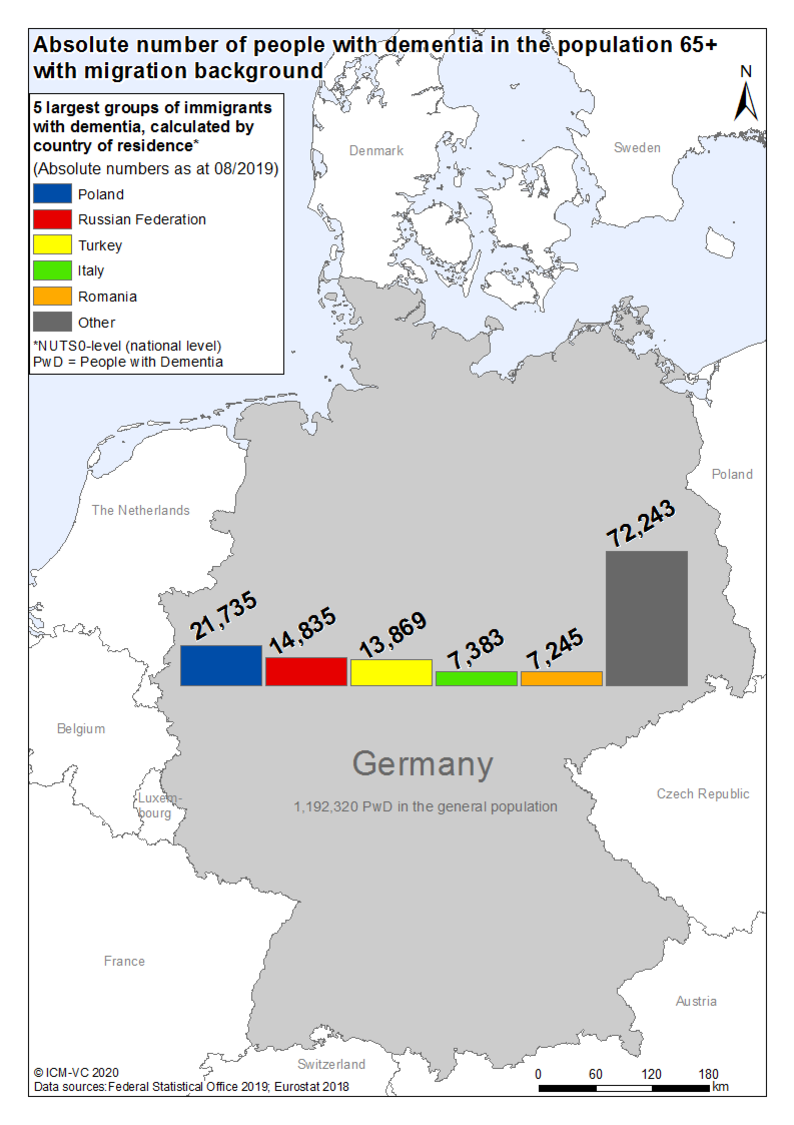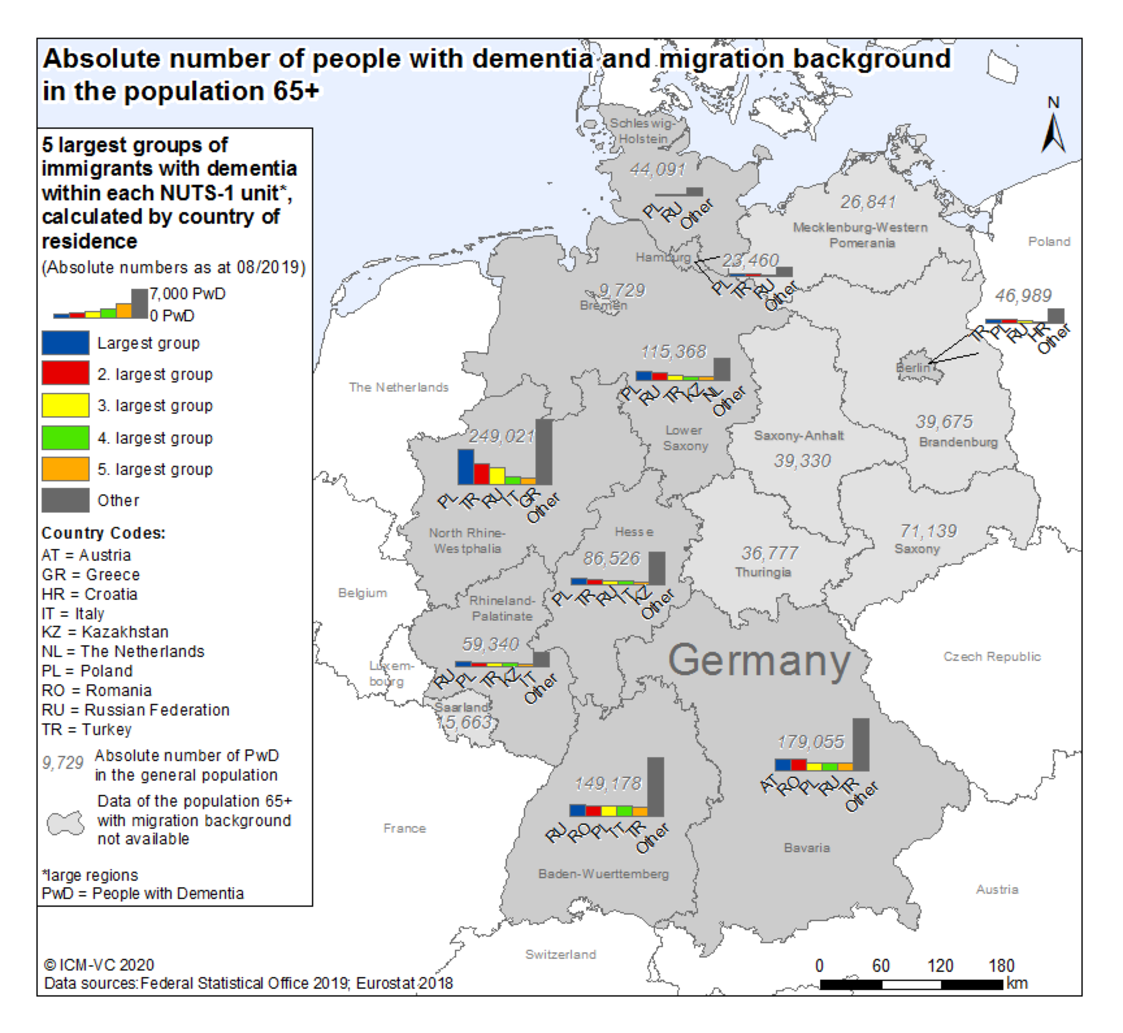| Largest group | 2. largest group | 3. largest group | 4. largest group | 5. largest group | |
| Absolute numbers | |||||
| PwMD per 100,000 inhabitants 65+ |
| Absolute numbers | PwMD per 100,000 inhabitants 65+ | |
| Largest group | ||
| 2. largest group | ||
| 3. largest group | ||
| 4. largest group | ||
| 5. largest group |
| Prevalence per 100,000 inhabitants 65+*, calculated by country of residence | |||
|---|---|---|---|
| high > PwMD |
minor > - PwMD |
||
| increased > - PwMD |
low ≤ PwMD | ||
| medium > - PwMD |
|||
| PwMD = People with a Migration background with Dementia *Bulgarien, Litauen, Malta, Polen in der Bevölkerung 60+ |
|||
| Absolute number of PwMD 65+ | |
| PwMD per 100,000 inhabitants 65+ |
Germany
Germany used to be a country of emigration but developed into a country of immigration due to economic reasons, military conflicts, recruitment of foreign workers, the Soviet Union's collapse, introduction of dual citizenship, the 2005 Immigration Act and high youth unemployment rates in southern Europe1,2,3. Between 1990 and 2019, the migrant population (born abroad) and their proportion in the total population (5.9 million [7.5%] to 13.1 million [15.7%]) more than doubled4.
There are 1,990,000 people with a migration background aged 65 or older. Of those, approx. 137,300 exhibit some form of dementia. The most affected migrant groups presumably originate from Poland (approx. 21,700), the Russian Federation (approx. 14,800), Turkey (approx. 13,900), Italy (approx. 7,400), and Romania (approx. 7,300)5.
Official documents on dementia care in individual federal states deal with dementia and migration to varying extents. The focus is on problem identification and description6-8.Germany's first national dementia strategy from 2020 refers to migration. In relation to the size of the document (152 pages), the topic does not play a key role, but it is dealt with to varying extents in 14 chapters or sub-chapters9.In the ‘S3 Guideline Dementias’ no direct reference to migration is made. One passage addresses it indirectly in the form of a discussion about the connection between sociocultural background/language skills and dementia diagnosis10. Overall, the topic of migration does not play a significant role in the German guidelines for dementia.
Acording to an expert, the care of people with a migration background with dementia is based on a hybrid model with segregative elements and integrative services. Existing counselling structures and information services often focus either on dementia or on migration background, but a combination of these characteristics or other aspects are rarely or never considered. Specialised services for outpatient and inpatient care of migrants with dementia are available in individual regions. Still, existing dementia-specific care services are neither suitable for people with nor for non-migrants. However, measures for intercultural care or support are locally widespread and in development.
Culturally sensitive care and training opportunities in intercultural care for professional caregivers exist but they play a subordinate role and are not mandatory. The proportion of professional caregivers with a migration background is just over 10% in outpatient care and just over 14% in inpatient care. Thecurrent level of awareness of diversity and cultural differences among healthcare professionals is not sufficient to meet the need for person-centred care.
Family and medical healthcare service providers play a very important role in supporting family caregivers, while religious communities and migrant organisations are considered to be of moderate or low importance. Multilingual information exists, but is hardly used and the need for specialised services providing support and information to family caregivers is very high.
References
- Oltmer J: Migration. In: Deutschland in Daten: Zeitreihen zur Historischen Statistik. edn. Edited by Rahlf T. Bonn: Bundeszentrale für politische Bildung; 2015.
- Migrationsgeschichte in Deutschland [https://www.domid.org/de/migrationsgeschichte-deutschland]
- Geschichte der Migration in Deutschland [https://www.bpb.de/gesellschaft/migration/dossier-migration/252241/deutsche-migrationsgeschichte]
- International Organization for Migration: International migrant stock as a percentage of the total population at mid-year 2019: Germany; 2019.
- Federal Statistical Office: Mikrozensus 2018; 2019.
- Bayerisches Staatsministerium für Arbeit und Sozialordnung Familie und Frauen: Bayerische Demenzstrategie. In.: Bayerisches Staatsministerium für Gesundheit und Pflege; 2013.
- Kirchen-Peters S, Hielscher V: Gemeinsam für ein demenzfreundliches Saarland: Erster Demenzplan des Saarlandes. In. Edited by Ministerium für Soziales G, Frauen und Familie des Saarlandes. Saarbrücken; 2015.
- Ministerium für Soziales Gesundheit Jugend Familie und Senioren: Demenzplan für Schleswig-Holstein erstellen und umsetzen. In. Kiel; 2015.
- Bundesministerium für Familie S, Frauen und Jugend, Bundesministerium für Gesundheit: Nationale Demenzstrategie. In., vol. 1; 2020.
- Deutsche Gesellschaft für Psychiatrie und Psychotherapie Psychosomatik und Nervenheilkunde, Deutsche Gesellschaft für Neurologie: S3-Leitlinie "Demenzen"; 2016.



![[Translate to Englisch:] Logo RBS [Translate to Englisch:] Logo RBS](/fileadmin/_processed_/9/7/csm_RBS_Logo_RGB_0e245a98a4.jpeg)